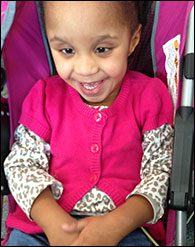 Home
Home- About H&V
- Resources
- Services
- Chapters
 Jayla Morrison
Jayla Morrison My daughter, Jayla Amel Morrison was born in June, 2009. I had no idea that these three and a half years would be as challenging as they have been. At three months, Jayla was diagnosed with Peroxisomal Biogenesis Disorder (PBD). We really didn't receive much information during that first meeting at Children’s Hospital. The only thing I really remember was the doctor saying the majority of babies diagnosed with this disorder only live a year or two and that there was no real treatment. PBD is a rare, genetic, metabolic, and in most cases terminal condition, affecting all major systems of the body. Children with this disorder generally experience hearing and vision loss, along with many other difficulties.
After many hours of research, we discovered the work being done in Barcelona by Dr. Manuela Martinez. We immediately made contact with her and in December of 2009 took our first trip to Barcelona. After just a short time working with Dr. Martinez, we saw an obvious improvement in our beautiful girl. Prior to the visit, Jayla showed all of the typical signs of someone with this complex disorder: low muscle tone, irritability, and a general failure to thrive. That first trip was about four weeks long, and when we returned, you would have thought we brought back a different baby. Jayla was alert, making cute babbling noises, and was even trying to sit up on her own! Ever since then, Jayla has been making amazing progress (at her own pace of course).
This past summer, we were fortunate enough to be able to travel to Orlando, Florida, for the Global Foundation for Peroxisomal Disorders (GFPD) 2012 Family Support Conference. This is an annual conference which brings families that are affected by PBD and the Zellweger Spectrum of Disorders (or PBD-ZSD), along with a wonderful physician team that is dedicated to the research and future treatment of this devastating disorder. Meeting other parents that are experiencing the same challenges that come with a child with special needs was so refreshing. Also, to see the other PBD kids (as we affectionately call them) making great progress despite their many health problems was an unexpected bonus.
There was a great deal of information presented at this conference. The physicians provided an update on the latest treatment research. Through the dedicated medical and scientific advisory team, a drug trial that could provide hope for children diagnosed with the disorder is on the horizon. Also, participants in the conference learned about the development of a diagnosis and management algorithm for children with PBD, the announcement of the adoption and approval of a grant application for researchers interested in pursuing projects, and a natural history study was presented in hopes of recruiting patient participants. Of course, all the families were interested.
I found it invaluable to have the opportunity to learn directly from professionals specializing in Jayla’s condition and to meet families traveling a similar journey. Attending such a conference did take some effort. We contacted many different organizations for assistance with the tuition and travel expenses. Most said no, but we did get some support to attend. This was my first time attending the conference, but I immediately knew that I made a great choice in putting forth the effort to be there.
For me, the most rewarding part of the conference was the interaction with other families that are affected by PBD-ZSD, and the children themselves. Through this journey, parents become experts on what works best for their children. I gained valuable insight into the world of deafblindness! Parents were more than willing to share how they have been able to gain the very best care for their children through their local medical community, as well as maneuvering through the education system with a child who has combined hearing and vision loss. I am now putting this information to great use, especially in the area of education, giving my daughter the best opportunity possible. Jayla is now attending preschool with other visually impaired children and has already made so much progress. She is a beautiful bright girl and we know she has plenty to tell us, when the time comes!
H&V Communicator - Spring 2013